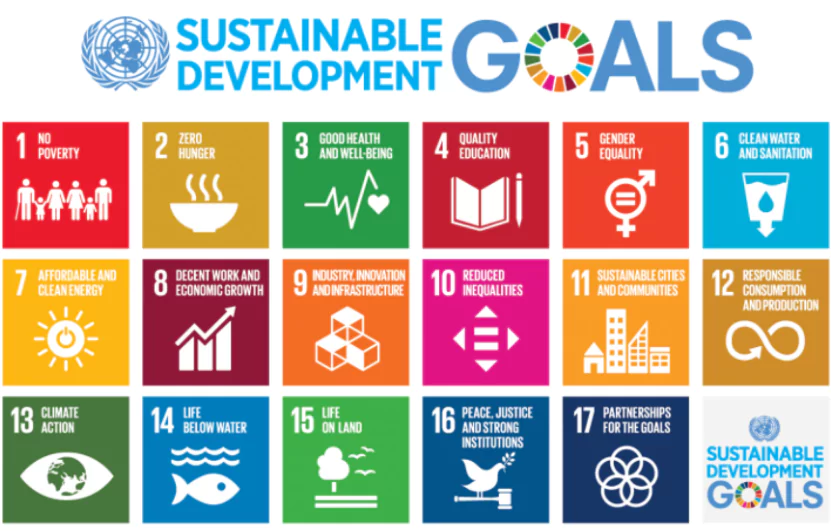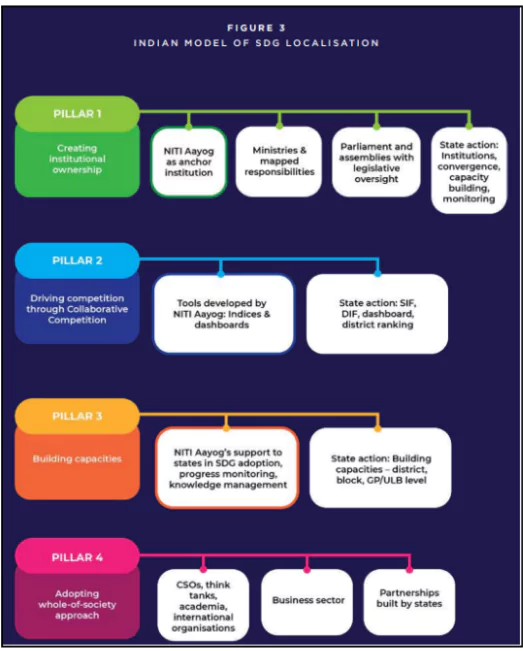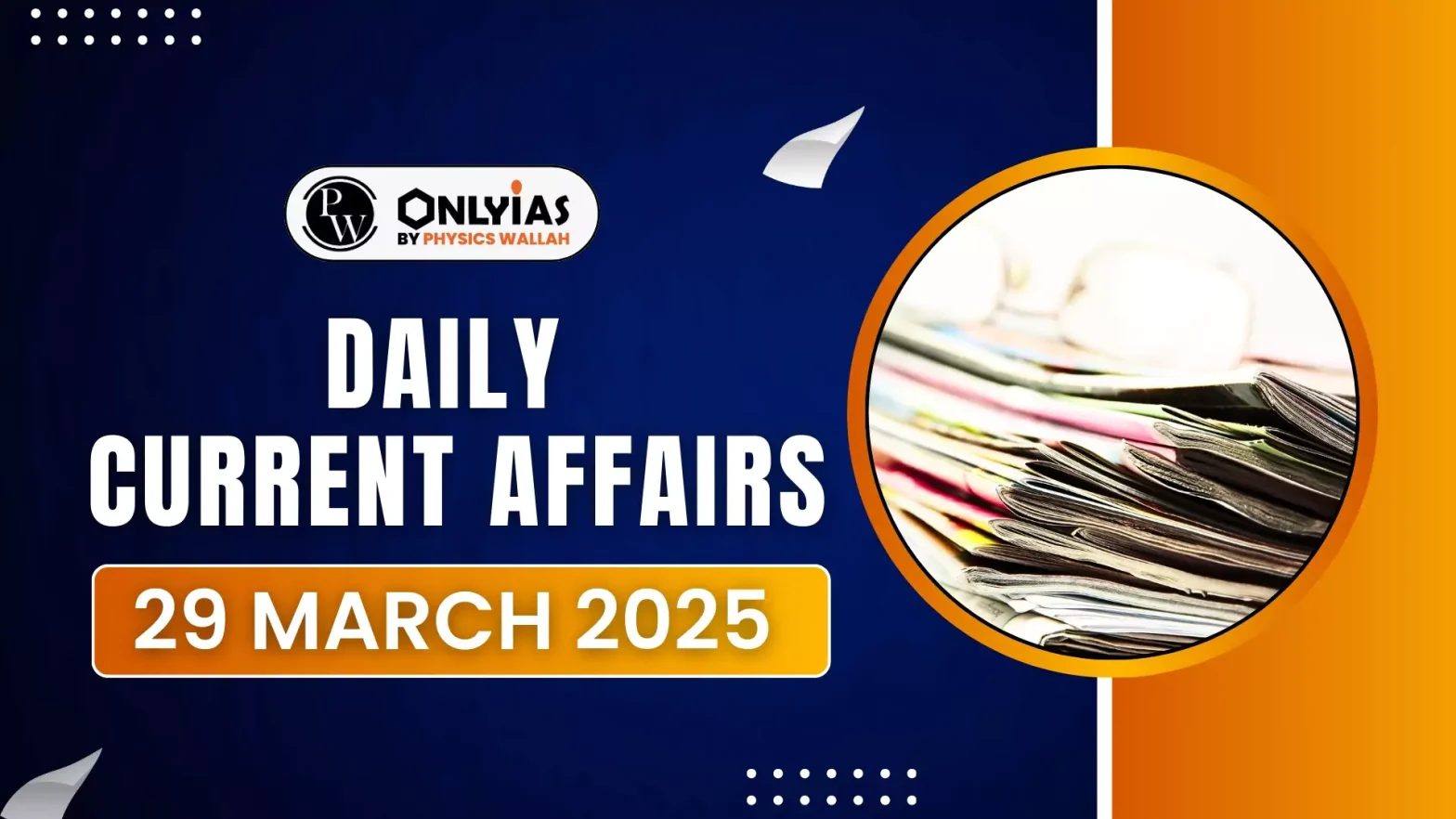India has reported significant progress, as reflected in the SDG index, which ranks countries on their attainment of the United Nations Sustainable Development Goals (SDGs).
India’s Overall Progress on SDGs
- SDG Index Growth: Score increased from 57 in 2018 to 71 in 2023-24.
- Average increase in state-wise composite index: 5 units between 2020-21 and 2023-24.
- State Performance: Average increase of 5 units (2020-21 to 2023-24); some states improved by 8 units.
- Localisation of SDG Implementation: State and district indices foster competition in policy formulation and service delivery.
State-wise Performance and Challenges

- Top Performing States:
- Kerala and Uttarakhand: Scores >80 in 8 SDG goals.
- Andhra Pradesh, Karnataka, Tamil Nadu, Telangana, West Bengal: Scores >80 in 6 goals.
- Punjab and West Bengal: Steady improvement across all goals.
- Declining Performance:
- Moderation in Performance: Declines are reported in:
- Goal 1: No Poverty
- Goal 5: Gender Equality
- Goal 10: Reduced Inequality
- Goal 16: Peace, Justice, and Strong Institutions
- Decline in Scores: Nine or more states have reported a decline in these goals.
- Some states have witnessed declines in six goals or more.

About Sustainable Development Goals
- Adoption: It was adopted by the UN General Assembly in 2015.
- Focus: It identified 17 SDGs with 169 specific targets to be achieved by 2030.
- Mandate: The programme is internationally non-binding, but all countries have committed to work towards these goals as transiting to sustainable development is a common global endeavor.
Government initiatives to promote SDGs
- Swachh Bharat Mission (SBM): Aims to achieve universal sanitation coverage and eliminate open defecation (SDG 6 – Clean Water and Sanitation).
- Poshan Abhiyaan: Focuses on improving nutritional outcomes for children, pregnant women, and lactating mothers (SDG 2 – Zero Hunger).
- Beti Bachao Beti Padhao (BBBP): Promotes gender equality and aims to improve child sex ratio (SDG 5 – Gender Equality).
- National Solar Mission: Aims to promote the use of solar energy to reduce dependency on fossil fuels (SDG 7 – Affordable and Clean Energy).
- Skill India Mission: Focuses on providing vocational training to youth to enhance employability (SDG 8 – Decent Work and Economic Growth).
- Jal Jeevan Mission: Ensures safe and adequate drinking water through individual household tap connections (SDG 6 – Clean Water and Sanitation).
|
About SDG Localisation
- The process of adapting and implementing the Sustainable Development Goals (SDGs) at sub-national (state, district, block) and local levels to align with local needs, capacities, and priorities.
- Key Principle: “Leaving No One Behind” (LNOB), ensuring equitable progress across all regions and communities.
|
India’s Approach to SDG Localisation

- NITI Aayog as Nodal Agency: NITI Aayog leads India’s SDG efforts, coordinating with states, Union Territories (UTs), and other stakeholders to localize the 2030 Agenda, ensuring a “whole-of-government” approach.
- Sub-National Engagement: Recognizing India’s federal structure, the approach emphasizes collaboration with states and UTs, integrating SDGs into local planning, budgeting, and monitoring frameworks (e.g., state-level SDG Coordination Centres).
- Monitoring Frameworks: Tools like the SDG India Index, National Indicator Framework (NIF), and District Indicator Framework (DIF) track progress at national, state, and local levels, fostering data-driven governance.
- Inclusive Development: Guided by “Sabka Saath, Sabka Vikas” (development for all), initiatives target vulnerable groups (e.g., women, children, SC/ST, disabled) through schemes like disability camps and financial assistance in UTs like Andaman & Nicobar.
- Capacity Building and Awareness: States and UTs conduct sensitisation and training programs (e.g., Chandigarh, Jammu & Kashmir) to integrate SDGs into governance processes and build local administrative capacity.
- Partnerships: Collaboration with UNDP and other stakeholders accelerates SDG implementation (e.g., Ladakh’s SDGCC with UNDP), enhancing resource mobilization and technical support.
- SDG-Based Budgeting: States and UTs like Andaman & Nicobar link budgets to SDGs, aligning financial resources with sustainable development priorities for effective grassroots impact.
Differences Between MDGs and SDGs
- Scope: MDGs (8 goals) focused on poverty reduction in developing nations; SDGs (17 goals) are universal, integrating the environment, economy, and society.
- Approach: MDGs were top-down; SDGs involved participatory drafting with inputs from governments, NGOs, and private sectors.
- Themes: SDGs add new areas like climate action (SDG 13), sustainable cities (SDG 11), and inequality (SDG 10).
MDGs’ Success
- Achievements:
- Reduced Extreme poverty by 50% globally.
- Child mortality (MDG 4) dropped by 53% .
- Maternal mortality (MDG 5) fell by 45%.
- Criticism:
- Regional disparities: Sub-Saharan Africa lagged in poverty, education, and health.
- Narrow focus: Ignored inequality, climate change, and governance.
- Top-down approach: Limited ownership by developing nations.
- Legacy: The MDGs proved that targeted global goals work, inspiring the more inclusive SDGs.
|
Challenges in Budgeting and Expenditure for SDGs in India
- Inadequate Fiscal Space
- High Funding Requirement: Estimates suggest developing countries need $4 trillion annually to achieve SDGs.
- India’s current spending is insufficient to bridge the financing gap for sustainable development.
- Competing Priorities: Budget constraints with competing demands for sectors like health, education, and infrastructure affect SDG allocations.
- Mismatch Between Spending and Progress: Increased expenditure has not always translated into measurable improvements in SDG outcomes.
- Odisha: Limited progress in Goal 4 (Quality Education) and Goal 10 (Reduced Inequality) despite increased allocations.
- Haryana: Limited results in Goal 16 (Peace, Justice, and Strong Institutions).
- Meghalaya: Declines in Goal 1 (No Poverty) and Goal 4 (Quality Education) despite consistent funding.
- Lack of Robust Monitoring and Evaluation Frameworks
- Gaps in Data Collection: Periodic and reliable data sources are essential for tracking progress but remain inadequate.
- Current statistical frameworks may not capture real-time impact, leading to delayed identification of gaps.
- Inadequate Impact Assessment: Limited ability to assess whether public expenditure is achieving desired results.
- Evaluation systems often overlook the interaction between different SDGs, contributing to suboptimal outcomes.
- Fragmented Implementation Across States
- Varied State Capacities: Uneven capacities among states in implementing and monitoring SDG budgets.
- Some states have integrated SDG budgeting (e.g., Haryana, Odisha, Meghalaya), but progress varies.
- Decentralized Governance Gaps: State and local governments often lack the expertise and resources to design and execute SDG interventions effectively.
- Lack of Long-term Planning and Resource Allocation
- Short-term Focus: Budgeting processes often prioritize short-term results over long-term sustainability.
- SDGs require sustained investment and a multi-year perspective to ensure meaningful progress.
- Time Lag Between Spending and Outcomes: Outcomes from increased public expenditure may take several years to materialize, making it difficult to attribute immediate progress or declines to spending alone.
- Lag Effect: Policies and programs often require a gestation period before the impact is reflected in SDG indicators.
Challenges Beyond Financing in Achieving SDGs in India
- Ineffective Implementation of Policies
- Policy Design vs Ground Reality: Well-intentioned policies often fail due to poor implementation at the grassroots level.
- Example: Haryana: Declines in Goal 16 despite budget allocations.
- Coordination Gaps: Lack of synergy between different departments and agencies hinders smooth execution of SDG-related policies.
- Measurement and Data Limitations
- Inconsistent Data Collection: Periodic and reliable data sources are essential for monitoring progress but remain inadequate.
- Inability to Capture Progress: Current statistical frameworks do not fully capture nuanced changes or declines in SDG indicators.
- Inaccurate data can lead to misallocation of resources and hinder evidence-based policymaking.
- Neglect of Trade-offs and Synergies Between Goals
- Interconnected Goals Overlooked: SDGs are inherently interlinked, and interventions often create trade-offs or synergies.
- Example: Goal 8 (Decent Work and Economic Growth) may conflict with Goal 13 (Climate Action) if environmental sustainability is compromised.
- Missed Opportunities for Cross-Sector Impact: Failure to model and manage these interactions can lead to suboptimal outcomes and wasted resources.
- Governance and Institutional Challenges
- Fragmented Decision-making: Multiple agencies handling different SDGs often work in silos, reducing coordination.
- Capacity Gaps at State and District Levels: Uneven capacity across states affects the quality of policy design, implementation, and monitoring.
- Local governments often lack the technical expertise and resources needed to manage SDG-related initiatives.
- Short-term Focus Over Long-term Sustainability
- Budgeting and Planning Issues: SDG achievements require sustained efforts, but budgeting tends to prioritize short-term outcomes.
- Lack of Multi-year Vision: Absence of a long-term perspective in planning and spending reduces the likelihood of sustainable progress.
- Exclusion and Inequality
- Marginalized Communities Left Behind: Despite efforts to reduce inequality, marginalized groups, including women, Dalits, and tribal communities, continue to face barriers to accessing services and benefits.
- Urban-Rural Disparities: Rural areas, with limited access to quality education, healthcare, and employment, show slower progress in achieving SDGs.
Examples of Countries Achieving SDGs
Finland: Top Performer in SDG Index
- High performance in quality education (Goal 4), gender equality (Goal 5), and clean energy (Goal 7).
Sweden: Circular Economy and Climate Action
- Leader in climate action (Goal 13) with significant reduction in carbon emissions.
- Implementation of a circular economy model to minimize waste and maximize resource efficiency.
- Swedish Climate Act (2017): Legally binding targets to achieve net-zero emissions by 2045.
Japan: Disaster Resilience and Sustainable Cities
- Effective policies in disaster risk reduction (Goal 11: Sustainable Cities and Communities).
- Society 5.0: A blueprint for using AI, IoT, and big data to enhance disaster resilience and urban governance.
Costa Rica: Environmental Conservation and Biodiversity Protection
- Remarkable success in protecting biodiversity (Goal 15: Life on Land) and adopting sustainable agriculture.
- Payment for Environmental Services (PES) Program: Incentivized farmers and communities to protect forests and natural resources.
South Korea: Technology and Innovation for SDGs:
- Leveraged technology to improve education (Goal 4), healthcare (Goal 3), and e-governance (Goal 16).
|
Way Forward for Achieving SDGs in India
- Strengthen Data Systems and Monitoring: Establish a robust real-time data framework to track SDG progress effectively.
- Periodic updates and reliable disaggregated data are essential for measuring outcomes and correcting course.
- Enhance Multi-level Governance and Coordination: Improve coordination between Union, State, and District levels to avoid duplication of efforts.
- Develop cross-sectoral frameworks to manage trade-offs and synergies between different SDGs.
- Align Budgeting with Local Priorities: Adopt a bottom-up approach by aligning financial allocations with state and district-specific needs.
- Strengthen participatory budgeting to ensure that marginalized communities’ voices are included.
- Promote Capacity Building and Institutional Strengthening: Invest in capacity-building programs for local governments and institutions to ensure efficient policy implementation.
- Equip local bodies with the technical skills needed for SDG tracking and management.
- Model Trade-offs and Synergies Between Goals: Use comprehensive modelling frameworks to assess interlinkages between goals and optimize resource allocation.
- Ensure that interventions in one sector do not negatively impact progress in another.
- Improve Public Awareness and Participation: Increase awareness and public engagement on SDGs to build accountability.
- Leverage civil society and private sector partnerships to complement government efforts.
- Adopt a Long-term Vision with Sustained Commitment: Shift focus from short-term outcomes to long-term sustainable growth.
- Ensure policy continuity and adaptive learning mechanisms to adjust strategies based on evidence.
Conclusion
Achieving SDGs in India requires a multi-pronged, data-driven, and participatory approach that strengthens local governance, optimizes resources, and enhances coordination across sectors. A long-term, sustained commitment will be key to translating policies into measurable outcomes.
Additional Readings: SDG India Index 2023-24
![]() 29 Mar 2025
29 Mar 2025




